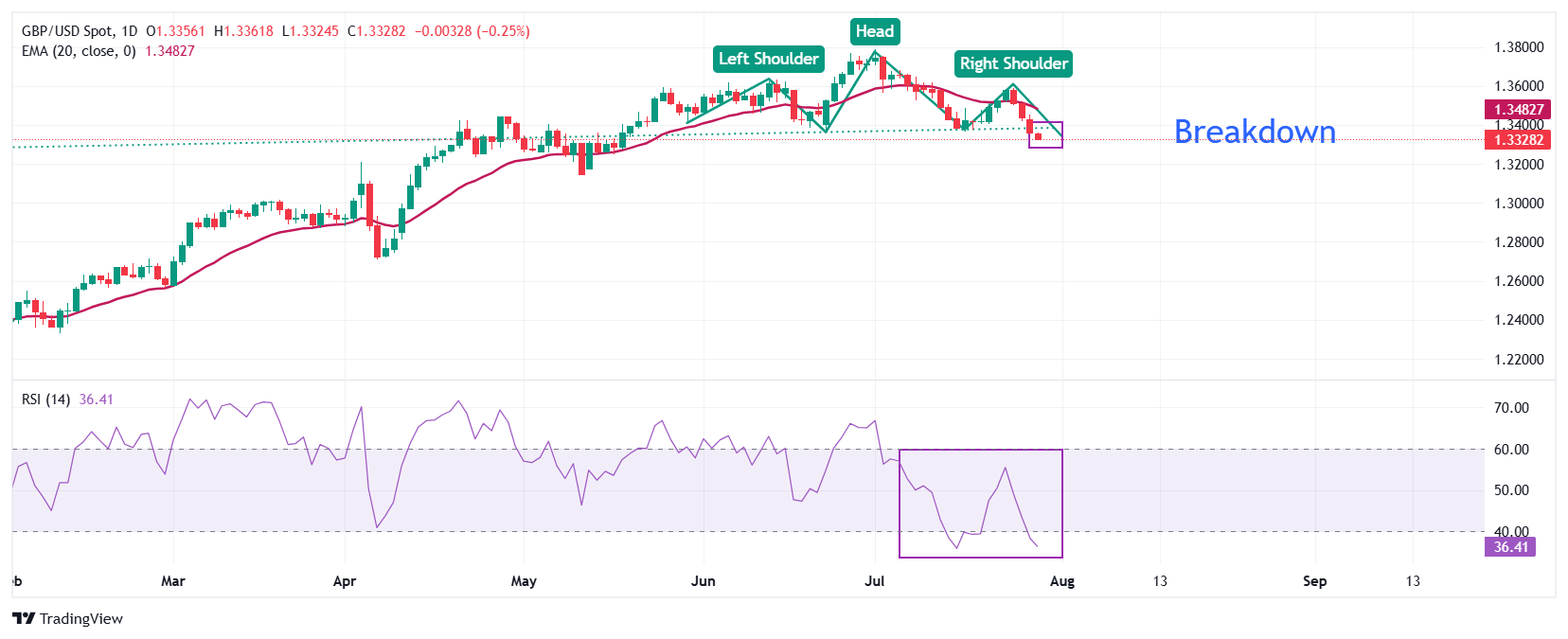Pound Sterling slumps against the US Dollar, focus shifts to Fed monetary policy
- The Pound Sterling trades weakly near 1.3350 against the US Dollar as the Greenback outperforms on the US-EU tariff deal.
- Investors expect the Federal Reserve to leave interest rates steady on Wednesday.
- Elevated UK inflation has weighed on households’ spending.
The Pound Sterling (GBP) holds onto losses near its two-month low around 1.3350 against the US Dollar (USD) during the European session on Tuesday. The GBP/USD pair faces selling pressure as the US Dollar trades firmly after officials from the United States (US) and the European Union (EU) approved a trade agreement ahead of the August 1 tariff deadline over the weekend.
At the time of writing, the US Dollar Index (DXY), which tracks the Greenback’s value against six major currencies, trades close to a weekly high near 98.70.
The appeal of the US Dollar has strengthened as the US-EU trade deal has put fears of disruption in Washington’s supply chain to an end, given the scale of business between both economies.
Meanwhile, investors await the outcome of high-level trade talks between the US and China, which are taking place in Stockholm from Monday. A report from the South China Morning Post (SCMP) showed on Monday that Washington and Beijing are expected to “extend their tariff truce for 90 days”, which will expire on August 12.
Daily digest market movers: Pound Sterling trades with caution against its peers
- The Pound Sterling trades cautiously against its peers on Tuesday. The British currency has been underperforming over the last seven trading sessions due to cooling labor market conditions and elevated inflationary pressures, a scenario that could force the Bank of England (BoE) to perform a balancing act in its monetary policy announcement next week.
- Rising inflationary pressures have started biting households’ spending power. A survey by the Confederation of British Industry (CBI) showed on Monday that retail sales declined for the 10th straight month in July. However, the pace of decline in retail sales was less severe than what was seen in June. The data came in at -34, improved from -46 in June.
- "Firms reported that elevated price pressures – driven by rising labour costs – and economic uncertainty continue to weigh on household demand, which has contributed to sales volumes falling since October 2024," analysts at CBI said.
- Meanwhile, traders are increasingly confident that the BoE will reduce interest rates in August’s monetary policy meeting.
- This week, the GBP/USD pair will be influenced by the Federal Reserve’s (Fed) monetary policy announcement on Wednesday. The Fed is certain to leave interest rates steady in the range of 4.25%-4.50% for the fifth consecutive time. Investors will pay close attention to guidance from the central bank on inflation and interest rates.
- In Tuesday’s session, investors will focus on the US JOLTS Job Openings data for June, which will be published at 14:00 GMT. Economists expect US companies to have posted 7.55 million jobs, slightly lower than 7.77 million in May.
British Pound PRICE Last 7 days
The table below shows the percentage change of British Pound (GBP) against listed major currencies last 7 days. British Pound was the weakest against the US Dollar.
| USD | EUR | GBP | JPY | CAD | AUD | NZD | CHF | |
|---|---|---|---|---|---|---|---|---|
| USD | 1.37% | 1.22% | 0.83% | 0.50% | 0.36% | 0.26% | 1.06% | |
| EUR | -1.37% | -0.12% | -0.50% | -0.84% | -1.01% | -1.01% | -0.28% | |
| GBP | -1.22% | 0.12% | -0.40% | -0.72% | -0.89% | -0.95% | -0.16% | |
| JPY | -0.83% | 0.50% | 0.40% | -0.30% | -0.48% | -0.48% | 0.18% | |
| CAD | -0.50% | 0.84% | 0.72% | 0.30% | -0.17% | -0.22% | 0.56% | |
| AUD | -0.36% | 1.01% | 0.89% | 0.48% | 0.17% | -0.05% | 0.68% | |
| NZD | -0.26% | 1.01% | 0.95% | 0.48% | 0.22% | 0.05% | 0.74% | |
| CHF | -1.06% | 0.28% | 0.16% | -0.18% | -0.56% | -0.68% | -0.74% |
The heat map shows percentage changes of major currencies against each other. The base currency is picked from the left column, while the quote currency is picked from the top row. For example, if you pick the British Pound from the left column and move along the horizontal line to the US Dollar, the percentage change displayed in the box will represent GBP (base)/USD (quote).
Technical Analysis: Pound Sterling delivers H&S breakdown

The Pound Sterling trades lower to near 1.3350 against the US Dollar at the time of writing on Tuesday, the lowest level seen in two months. The GBP/USD pair slides after a breakdown of the Head and Shoulders (H&S) chart pattern on a daily timeframe, following a downside move below the neckline plotted near 1.3413.
The pair trading below the 20-day Exponential Moving Average (EMA), which is around 1.3483, also suggests that the near-term trend is bearish.
The 14-day Relative Strength Index (RSI) slides below 40.00, indicating that a fresh bearish momentum has been triggered.
Looking down, the May 12 low of 1.3140 will act as a key support zone. On the upside, the July 1 high around 1.3790 will act as a key barrier.
Pound Sterling FAQs
The Pound Sterling (GBP) is the oldest currency in the world (886 AD) and the official currency of the United Kingdom. It is the fourth most traded unit for foreign exchange (FX) in the world, accounting for 12% of all transactions, averaging $630 billion a day, according to 2022 data. Its key trading pairs are GBP/USD, also known as ‘Cable’, which accounts for 11% of FX, GBP/JPY, or the ‘Dragon’ as it is known by traders (3%), and EUR/GBP (2%). The Pound Sterling is issued by the Bank of England (BoE).
The single most important factor influencing the value of the Pound Sterling is monetary policy decided by the Bank of England. The BoE bases its decisions on whether it has achieved its primary goal of “price stability” – a steady inflation rate of around 2%. Its primary tool for achieving this is the adjustment of interest rates. When inflation is too high, the BoE will try to rein it in by raising interest rates, making it more expensive for people and businesses to access credit. This is generally positive for GBP, as higher interest rates make the UK a more attractive place for global investors to park their money. When inflation falls too low it is a sign economic growth is slowing. In this scenario, the BoE will consider lowering interest rates to cheapen credit so businesses will borrow more to invest in growth-generating projects.
Data releases gauge the health of the economy and can impact the value of the Pound Sterling. Indicators such as GDP, Manufacturing and Services PMIs, and employment can all influence the direction of the GBP. A strong economy is good for Sterling. Not only does it attract more foreign investment but it may encourage the BoE to put up interest rates, which will directly strengthen GBP. Otherwise, if economic data is weak, the Pound Sterling is likely to fall.
Another significant data release for the Pound Sterling is the Trade Balance. This indicator measures the difference between what a country earns from its exports and what it spends on imports over a given period. If a country produces highly sought-after exports, its currency will benefit purely from the extra demand created from foreign buyers seeking to purchase these goods. Therefore, a positive net Trade Balance strengthens a currency and vice versa for a negative balance.

